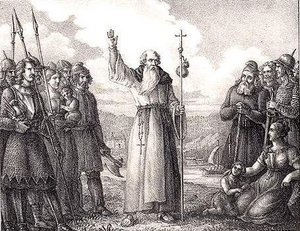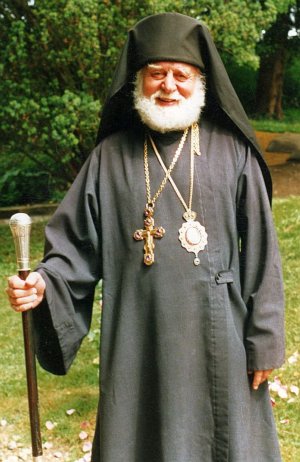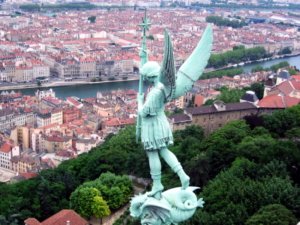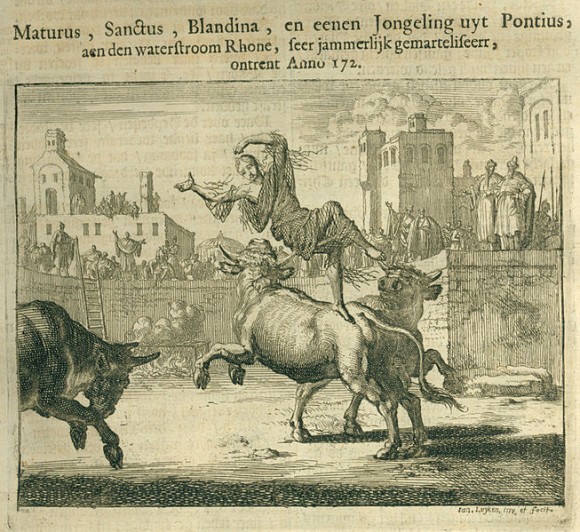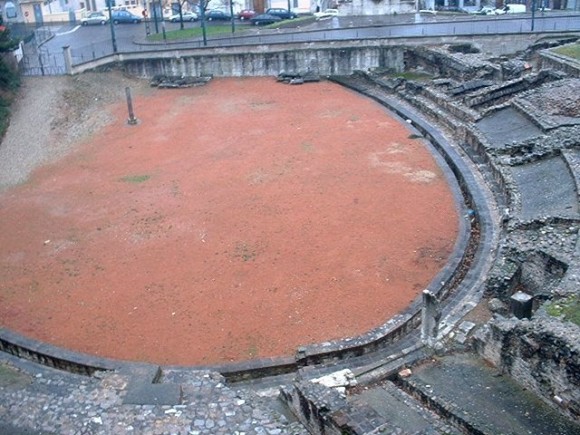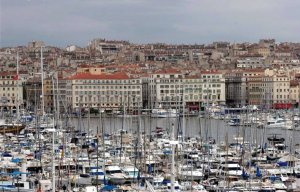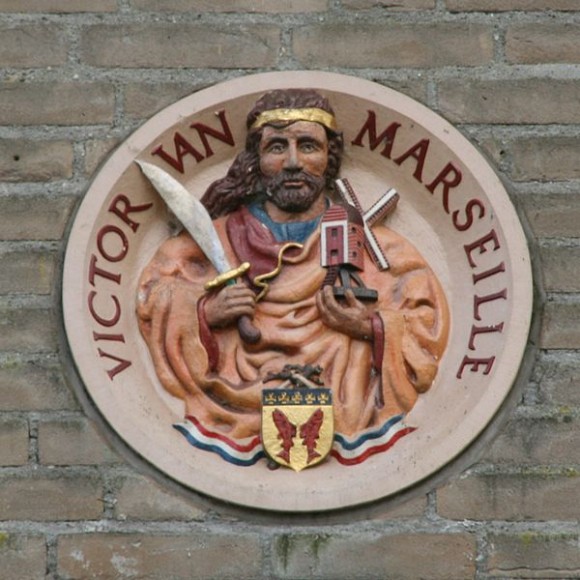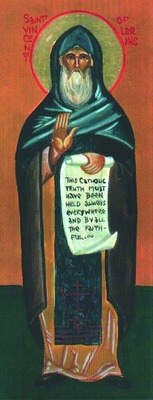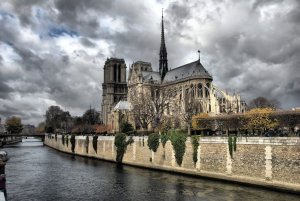St. Olaf was born in 995, the son of a Norwegian lord named Harald Grenske, the great grandson of Harald Fairhair, and Asta Gudbransdatter. Olaf grew up in the household of his stepfather, Sigurd Byr of Ringarike. From the age of 12, he went on expeditions to the Baltic coast, Denmark and the Netherlands. Between 1009 and 1013 he fought under Thorkell the Tall against the English at London, Ringmere and Canterbury. For a time he was a captain of mercenaries for Duke Richard of Normandy, and in 1013 or 1014 he was converted to the Faith of Christ and baptized in Rouen. Then he entered the service of the exiled English King Ethelred and followed him back to England, where he fought on the English side at the taking of London Bridge. When the Danish King Canute conquered England, Olaf joined his service.
According to The Saga of St. Olaf, the two men were at first great friends. However, King Canute then became jealous of the younger man. Moreover, the Saga continues, "the bishop [St. Sigfrid, enlightener of Sweden] always waited for Olaf at Divine service, but not for Canute, and the bishop called Olaf king, and this Canute could not bear to hear, and spoke to the bishop about it in such strong words that the latter had to desist, because of the king's authority, for the king's heart was filled to overflowing with pride and ambition, because of his power and place. So things went on until it came to Lent. Then Canute began to speak to Sigfrid: 'Is it true that you called Olaf by the title of king this winter? Now how do you defend your words, when he has no settled country nor wears a crown?'
"'It is true, my lord,' said the bishop, 'that he has no land here, and he wears no crown of gold or silver. Nay, rather is he chosen and crowned by the highest Lord and Ruler, the King of all kings, the one almighty God, to rule and govern that kingdom to which he is born, and this special destiny awaits him, to rule a kingdom for the comfort and profit of the people, and to yield to God the fitting fruit of his coming into his kingdom. All the people in Norway and the lands tributary to it, and not these parts only, but no less the whole of the region of the north as well, shall have reason to remember and keep in mind this pillar and support of God's Christendom, who will root out all brambles and weeds from God's field and vineyard, and sow in their stead the noble seed of God's holy words. All these words will flourish and come to perfect growth, and every man who accepts them will himself be acceptable to the highest King of heaven, world without end.'
"King Canute said: 'You cannot be said to have made good the words which we are told you have spoken, my lord Bishop, declaring that he outshines us in miraculous virtues, above all if you make so great a distinction between us, that you declare that we show no virtues at all.'
"'You have heard rightly concerning these words of ours,' said the bishop.
"King Canute said: 'It avails me little, then, to chastise myself more than King Olaf, if I am bound to fall short of him in some respect, for now, since Lent has begun, I wear a linen and not a silken shirt, a scarlet kirtle, and not one of velvet or purple. I drink also ale and not mead. But Olaf wears a shirt of silk and a kirtle of velvet. He has the choicest foods prepared for him, and a vessel of wine stands on his table.'
"The bishop said: 'It is true, my lord, that Olaf wears a shirt of silk, but he wears a hair-cloth under the shirt, and a belt about his body so broad that it reaches from hip to shoulder-blade, and iron extending from it in front. You will always see that when King Olaf takes his seat and the choicest foods are brought before him, there is a mound in the place where he is wont to sit. There is hidden a cripple, and it is he that eats the dainties, but Olaf eats salt and bread. There is also a vessel of water, and this Olaf drinks, and has no more to drink than that, but it is the cripple that drinks out of the wine-cup.'
"Then King Canute was so enraged against Bishop Sigfrid, that King Olaf could not stay there because of the jealousy of King Canute, and a little later it went the same way with Bishop Sigfrid."
In 1015 Olaf and Sigfrid went to Norway, where Olaf succeeded in seizing the kingdom in spite of much opposition. First, by distributing money, and with the support of his kinsmen on the Opplands, he gained control of Ostland. Then, on Palm Sunday, March 25th, 1016, he conquered the country's principal chieftains, Sven Hakonsson Jarl, Einar Tambarskjelve, and Erling Skjalgsson, in the sea battle at Nesjar (between Larviksfjord and Lengesundsfjord). In the same year he was accepted as King at the Oreting in Trondelag.
He had a comparatively peaceful reign for almost 10 years, and during this period considerably advanced the unification of Norway. Olaf's work of unification assumed concrete form as territorial dominion over a kingdom which extended from Gautelven in the south up to Finnmark in the north, from the Vesterhav islands in the west to the forests toward the realm of the Swedes in the east. Olaf was the first high king who secured real control over the inland areas of Trondelag and Opplandene. Moreover, he gained a foothold for the Norwegian national kingdom on the Orkney islands and Hjaltland.
Olaf also laid the foundation for nationwide local government and introduced a certain division of labor among the royal housecarls. He installed sheriffs recruited from the nobility and the landed gentry throughout the country and tried by means of his year-men to keep control of the political activities of the sheriffs. According to Snorre a division of labor seems to have occurred in the King's household into actual housecarls (military functions), guests (police functions), house chaplains, and churls (duties within the palace). Moreover, several titles of the masters of the King's court are known from this time: standard-bearer, King's Marshal, House Bishop.
With the aid of his English missionaries he succeeded in making Norway Christian. At the meeting of the Ting (Parliament) At Moster, Bomlo in Sunnhordland (1024), Norway acquired a nationwide ecclesiastical organization with churches and priests, a Christian legal system and a first organization of the Church's finances. Gwyn Jones writes: "The Christian law formulated at Moster was of prime authority; it was read out at the different Things, and there are confirmatory references to it in the oldest Gulathing Law." The king established peace and security for his people, remaking old laws and insisting on their execution, unaffected by bribes or threats. He built many churches, including one dedicated to St. Clement at the capital, Nidaros (Trondheim). All other faiths except Christianity were outlawed.
At the beginning of his reign St. Olaf did not enjoy good relations with Sweden; for the Swedish King Olof Skotkonung had seized a portion of Norway in about the year 1000. However, through the mediation of St. Anna, King Olof's daughter, it was agreed that St. Olaf should marry his other daughter Astrid, and relations between the two Christian kings were restored. In this way the foundations were laid for the Christianization of the whole of Scandinavia.
After the death of the King Olof in 1022, St. Olaf made an alliance with his son Anund Jacob against Canute of England and Denmark. For Canute's hatred had not been extinguished; and the jealousy of this Cain was destined both to open a fruitful mission-field and to provide a martyr's crown for the latter day Abel. But in 1026 the allies were defeated by Canute at Helgean in Skane, Sweden.
Then, as Florence of Worcester writes, "since it was intimated to Canute, king of the English and Danes, that the Norwegians greatly despised their king, Olaf, for his simplicity and gentleness, his justice and piety, he sent a large sum of gold and silver to certain of them, requesting them with many entreaties to reject and desert Olaf, and submit to him and let him reign over them. And when they had accepted with great avidity the things which he had sent, they sent a message back to him that they would be ready to receive him whenever he pleased to come." So the next year (1028), "Canute, king of the English and Danes, sailed to Norway with 50 great ships, and drove out King Olaf and subjected it to himself," appointing the Danish earl Hakon, son of Eirik Jarl, whom Olaf had banished in 1015, as his viceroy.
Olaf decided to flee to Sweden and thence to the court of his kinsman, Yaroslav of Kiev, whose father, the famous St. Vladimir, had given shelter to Olaf Tryggvason in his youth. And it was the same Olaf Tryggvason who appeared to his successor and namesake one night and said:
"Are you sick at heart over which plan to take up? It seems strange to me that you are pondering so much, and similarly that you are thinking of laying down the kingdom which God has given you, and moreover that you are thinking of staying here and taking a kingdom [Bulgaria] from kings who are foreign and strangers to you. Rather go back to your kingdom which you have taken as your inheritance and have long ruled over with the strength God has given you, and do not let your underlings make you afraid. It is to a king's honor to win victories over his foes, and an honorable death to fall in battle with his men. Or are you not sure whether you have the right in this struggle? You will not act so as to deny your true right. You can boldly strive for the land, for God will bear you witness that it is your own possession."
In 1029 Hakon died in a shipwreck in the Pentland Firth on his way home to Norway. This gave Olaf his opportunity. Early in 1030 he set off for Norway over the frozen Russian rivers. When the sea-ice broke, he sailed to Gotland with 240 men. King Anund of Sweden gave him 480 more, but when he faced Canute's army at Stikrlarstadir, he had no more than 3600 men (Swedes, Jamtlanders from Northern Sweden, Icelanders and his Norwegian companions) against a peasant army 14,400 mrn - the largest army ever assembled in Norway.
Then, like Gideon, the saint decided to reduce his numbers by choosing only Christians to fight in his army. So he was eventually opposed by overwhelmingly larger forces. And as the sun went into total eclipse on July 29, 1030 (July 30, according to modern astronomers), his army was defeated and he himself was killed, as had been revealed to him in a vision just before the battle.
But immediately a great fear fell on the soldiers of Canute's army. And then miracles began to be manifested at St. Olaf's body: a light was seen over it at night; a blind man recovered his sight on pressing his fingers, dipped in the saint's blood, to his eyes; springs of water with healing properties flowed from his grave; and then, to the chagrin of Canute's first wife, Elgiva, and her son King Swein of Denmark, his body was found to be incorrupt. Soon the penitent Norwegians expelled the Danes, and recalled Olaf's son Magnus from Russia to be their king.
The incorruption of Olaf's body was certified by his loyal Bishop Grimkel, whose see was Nidaros (Trondheim). As we read in St. Olaf's Saga: "Bishop Grimkel went to meet Einar Tambarskelver, who greeted the bishop gladly. They afterwards talked about many things and especially about the great events which had taken place in the land. They were agreed among themselves on all matters. The bishop then went into the market and the whole crowd greeted him. He asked carefully about the miracles which were related of King Olaf and learned a great deal from this questioning. Then the bishop sent word to Torgils and his son Grim at Stiklastad, calling them to meet him in the town. Torgils and his son did not delay their journey, and they went to meet the bishop in the town. Then they told him all the remarkable things which they knew and also the place where they had hidden the king's body. The bishop then sent word to Einar Tambarskelver, and Einar came to the town. Einar and the bishop then had a talk with the king and Elgiva and asked the king to allow them to take up King Olaf's body from the earth. The king gave permission, and told the bishop to do it as he wished. Then a great crowd assembled in the town. The bishop and Einar then went with some men to the place where the king's body was buried and had it dug up. The coffin had by this time almost risen out of the earth. In accordance with the advice of many, the bishop had the king buried in the ground beside St. Clement's church. It was twelve months and five days from the death of the king to the day his holy relics were taken up, the coffin having risen out of the earth and looking as new as if it had just been planted. Bishop Grimkel then went to the opened coffin of King Olaf, from which there proceeded a precious fragrance. The bishop then uncovered the king's face, and it was completely unchanged: the cheeks were red as if he had just fallen asleep. Those who had seen King Olaf when he fell noticed a great difference in that his hair and nails had grown almost as much as they would have done if he had been alive in this world all the time since his fall. King Swein and all the chiefs who were there then went to see King Olaf's body.
"Then Elgiva said: 'A body rots very slowly in sand; it would not have been so if he had lain in mould.'
"The bishop then took a pair of scissors and cut off some of the king's hair and also some of his beard (he had a long beard, as was the custom at that time). Then the bishop said to the king and Elgiva:
"'Now the king's hair and beard are as long as when he died, and since then they have grown as much as you now see shorn off.'
"Then Elgiva answered: 'This hair will be a holy relic to me if it does not burn in the fire; we have often seen the hair of men who have lain longer in the earth than this man whole and unscathed.'
"The bishop then had fire brought in on a censer. He made the sign of the cross over it and put incense in it. Then he laid King Olaf's hair in the fire. And when all the incense had burned the bishop took up the hair from the fire and it was not burned. The bishop let the king and the other chiefs see it. Then Elgiva ordered them to lay the hair in unhallowed fire. But Einar Tambarskelver ordered her to be silent and said many hard words to her. Then the bishop declared, and the king agreed, and the people deemed, that King Olaf was truly holy. The king's body was then borne into St. Clement's church and placed over the high altar. The coffin was wrapped in a pall and over it was placed a beautiful cover. And then many miracles took place at the holy relics of King Olaf."
King Canute made no opposition to the veneration of St. Olaf, and churches dedicated to the saint were soon being built throughout the Viking world, from Dublin to the Orkneys to Novgorod. Forty ancient churches were dedicated to St. Olaf in Britain, and his feast occurs on several English calendars.
It was in connection with a miracle attributed to St. Olaf that a chapel was dedicated to him in Constantinople. Thus Bishop Ambrose von Sievers writes: "From other sources I have established that the Panagia Varangiotissa was situated by the western facade of Hagia Sophia, almost touching it. In about the reign of Alexis Comnenus (or a little earlier) St. Olaf was included among the saints of Constantinople and in the church of the Varangian Mother of God a side-chapel was built in honor of St. Olaf, while the old church itself was transformed into a church to which a women's monastery was attached."
According to the medieval Icelandic historian Snorri Sturluson, in 1066 as St. Olaf's half-brother, King Harald of Norway was preparing to invade England, he dreamed that he was in Trondheim and met St. Olaf there. Olaf told him that he had won many victories and died in holiness because he had stayed in Norway. But now he feared that he, Harald, would meet his death, "and wolves will rend your body; God is not to blame." Snorri wrote that "many other dreams and portents were reported at the time, and most of them were ominous." Harald was killed, in accordance with the prophecy of St. Olaf, at the Battles of Stamford Bridge in England.
Holy Martyr-king Olaf, pray to God for us!
By Vladimir Moss. Posted with permission.
(Sources: Heinskringla. The Saga of St. Olaf; King Harald's Saga, 82, translated by Magnusson & Palsson, Harmondsworth: Penguin books, 1966; Florence of Worcester, Chronicle; "The Life of the Holy Grand Princess Anna", Living Orthodoxy, vol. V, no. 1, January-February, 1983, pp. 14-18; The Norwegian Encyclopaedia and the Svenska Uppslagsbok, translated in Living Orthodoxy, vol. V, no. 3, May-June, 1983, pp. 27-30; David Farmer, The Oxford Dictionary of Saints, Clarendon Press, 1978; Gwyn Jones, A History of the Vikings, Oxford University Press, 1984; Bishop Ambrose (von Sievers) of the Goths, personal communication)
Celebrated July 29 (translation August 3)
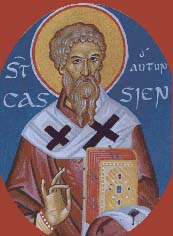
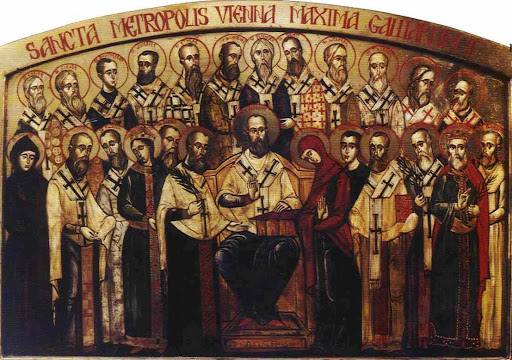



 Despite the universality of the Holy Orthodox Church, it is not infrequently that converts confess to feeling "out of place" in {he Russian, Greek, Serbian, or other ethnic tradition which, with few exceptions, dominates parish life in the Orthodox West. This is a natural outcome of the circumstances in which Orthodoxy spread to the West: it was primarily an immigrant rather than a missionary movement. Today, however, a majority of converts come from a West European stock which is neither Slavic nor Greek. Those of us whose ancestors are French, Irish, Scandinavian, German, Italian or other British or European nationality, would do well to remember that we too have a rich Orthodox heritage. Unhappily, it has in many cases been buried under a thick layer of Catholic and Protestant history. It would, however, serve not only our own interests, but the interest of the Orthodox Church as a whole, were we to bring to light that treasury of Western saints and their rich legacy--of which we are the unworthy inheritors.
Despite the universality of the Holy Orthodox Church, it is not infrequently that converts confess to feeling "out of place" in {he Russian, Greek, Serbian, or other ethnic tradition which, with few exceptions, dominates parish life in the Orthodox West. This is a natural outcome of the circumstances in which Orthodoxy spread to the West: it was primarily an immigrant rather than a missionary movement. Today, however, a majority of converts come from a West European stock which is neither Slavic nor Greek. Those of us whose ancestors are French, Irish, Scandinavian, German, Italian or other British or European nationality, would do well to remember that we too have a rich Orthodox heritage. Unhappily, it has in many cases been buried under a thick layer of Catholic and Protestant history. It would, however, serve not only our own interests, but the interest of the Orthodox Church as a whole, were we to bring to light that treasury of Western saints and their rich legacy--of which we are the unworthy inheritors. A similar task was undertaken by one who was himself an Orthodox saint of the West, St. Gregory, Pope of Rome—also known as St. Gregory the Great, or St. Gregory the Dialogist, Writing at the end of the sixth century, he compiled a book honoring the memory of the saints of Italy for the edification and instruction of his fellow countrymen. The book is written in the form of a dialogue between himself and his deacon Peter, from whose comments it St. Gregory the, Dialogist is clear that we are not alone in our ignorance of these holy and illustrious men of God.
A similar task was undertaken by one who was himself an Orthodox saint of the West, St. Gregory, Pope of Rome—also known as St. Gregory the Great, or St. Gregory the Dialogist, Writing at the end of the sixth century, he compiled a book honoring the memory of the saints of Italy for the edification and instruction of his fellow countrymen. The book is written in the form of a dialogue between himself and his deacon Peter, from whose comments it St. Gregory the, Dialogist is clear that we are not alone in our ignorance of these holy and illustrious men of God. Going north into France, we again discover a whole army of Orthodox saints: the desert-dwellers of the Jura Mountains, the monastic fathers of Lerins, the saintly bishops of Poitiers ,.Tours, Paris, Lyons. Numbered among their ranks is St. Ciotilde, Queen of France (d. 545), by whose prayers her husband, Clovis, King of the Franks, received the faith of Christ. where again we are fortunate in having primary sources available to us in English: St. Gregory of Tours'History of the Franks contains some lives of saints, while his magnificent Vita Patrum (Life of the Fathers) was translated by Hieromonk Seraphim and has appeared over the past few years in issues of "The Orthodox Word". In his Introduction to this series, Pr. Seraphim writes:
Going north into France, we again discover a whole army of Orthodox saints: the desert-dwellers of the Jura Mountains, the monastic fathers of Lerins, the saintly bishops of Poitiers ,.Tours, Paris, Lyons. Numbered among their ranks is St. Ciotilde, Queen of France (d. 545), by whose prayers her husband, Clovis, King of the Franks, received the faith of Christ. where again we are fortunate in having primary sources available to us in English: St. Gregory of Tours'History of the Franks contains some lives of saints, while his magnificent Vita Patrum (Life of the Fathers) was translated by Hieromonk Seraphim and has appeared over the past few years in issues of "The Orthodox Word". In his Introduction to this series, Pr. Seraphim writes: What convert of Irish ancestry doesn't have a devotion to St. Patrick? So successful were the apostolic labors of this wondrous saint that by the sixth century Ireland had become a genuine Thebaid of the West whose monastics penetrated the farthest corners of Europe in their missionary zeal. Wales, too, had an illustrious bishop, St. David, as its patron. Here was another breeding ground of missionary saints, many of whom are more illustrious in the lands they evangelized than in their homeland.
What convert of Irish ancestry doesn't have a devotion to St. Patrick? So successful were the apostolic labors of this wondrous saint that by the sixth century Ireland had become a genuine Thebaid of the West whose monastics penetrated the farthest corners of Europe in their missionary zeal. Wales, too, had an illustrious bishop, St. David, as its patron. Here was another breeding ground of missionary saints, many of whom are more illustrious in the lands they evangelized than in their homeland.


